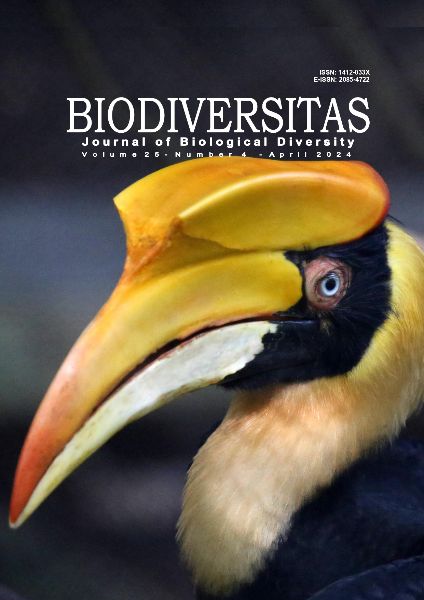Fish diversity and environmental factors at the Don Hoi Lot Ramsar Site, Thailand
##plugins.themes.bootstrap3.article.main##
Abstract
Abstract. Siriwattanarat R, Wongroj W, Ngamniyom A, Vilasri V, Chungthanawong S, Punnarak P. 2024. Fish diversity and environmental factors at the Don Hoi Lot Ramsar Site, Thailand. Biodiversitas 25: 1394-1403. The Don Hoi Lot mudflat, recognized as a Ramsar site, is a globally acclaimed wetland located in the Khlong Khon Sub-district of Samut Songkhram Province, Thailand. This research aims to study fish diversity and environmental variables at the Don Hoi Lot Ramsar Site; fish samples were collected using cast nets (mesh size 1.5 cm and 2.5 cm) and gill nets (mesh size of ¾ inch, 1.5 inches, and 2 inches) by local fisheries from four sampling stations which represented upstream (KK1), midstream (KK2), downstream (KK3), and estuary (KK4) zones in Khlong Khon Bay during January to April 2023. A total of 1,389 fish specimens were collected, representing 36 species belonging to 26 families. Higher diversity in number of species (28-35 species), Shannon index (2.90-2.98), and species richness (10.40-13.11) were found at downstream and estuary stations, while the lowest number of fish species (three species), Shannon index (0.75), and species richness (0.68) were recorded at the upstream station. Similarly, the higher relative abundance of fish (84-173 specimens) was observed at downstream and estuary stations, and the lowest relative abundance (29-50 specimens) was also reported at the upstream station. The blackchin tilapia (Sarotherodon melanotheron Rüppell 1852) was the dominant species at the Don Hoi Lot Ramsar Site during the study periods, followed by the Mozambique tilapia (Oreochromis mossambicus Peters 1852)). Principal component analysis (PCA) further revealed that altitude, temperature, pH, salinity, transparency, ammonia, phosphate and silicate had significant relationships within fish assemblages, whereas nitrite and nitrate were less important in this study. Nonetheless, the rapid expansion of the blackchin cichlid population has had an adverse impact on native fish populations, which could pose a real threat to fish diversity and population, and other aquatic organisms.

